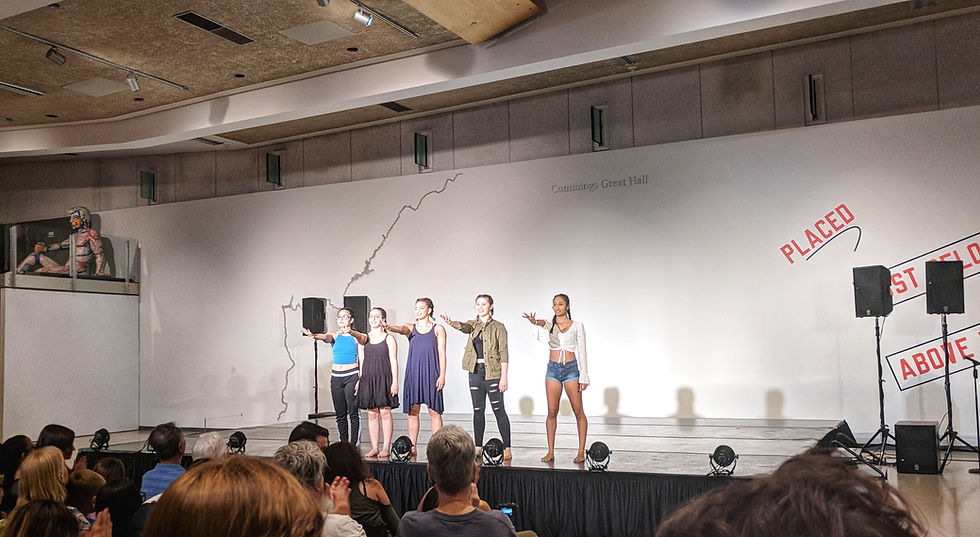DanceFest 2018: When Dance Becomes Emotion
- Heather Lynn Horvat
- Apr 11, 2018
- 4 min read
Robert Frost said, "Poetry is when an emotion has found its thought and the thought has found words." The same can be said of dance. When an emotion has found its expression and the expression has found its music, it is dance. This definition of dance was on display at the Phoenix Art Museum for DanceFest 2018, showing spectators the raw emotion of pure, uncensored joy.
In addition to the main stage in Cummings Great Hall, an interactive Tiny Dance Experience invited the audience to impromptu dance on a small stage. By venturing inside the belly of Arizona's largest museum, one witnessed pop-up performances in which dancers incorporated their expressions with art exhibits to demonstrate to viewers that art, in its many forms, can transcend all limits. Each piece of dance at DanceFest contributed to the overall demonstration of the emotional spectrum. I selected a few that lingered with me even after the sun rose the next morning.
On the main stage, two GCU students danced to "Sans Toi," a song of a lover leaving. Both male and female dancer appeared to have excellent command of footwork and arm movements. But more curious were their faces. In the final moments of the song, the female kneeled and begged for his love. He turned from her, rejecting her. Her face reflected deep anguish. His face portrayed finality; he was done with her. The song ended. Both dancers' faces changed into what I can only describe as joy. A smile transformed his face and he walked back to offer his hand to her. She stood, also with a wide smile, and they bowed together. I was left with chills by how dance acted as a conduit for two individuals to show love and rejection to the audience.
Central High School and their piece "The Springtime of Life" entered the main stage next. What struck me throughout this dance was that each dancer smiled. Not the plastered smile that one sometimes notes on professional dancers' faces, but rather an uncensored happiness. The Central dancers were here to have fun and to make sure the audience had fun also. Not always in sync with their moves, they didn't seem to mind, sometimes hiding a laugh because of bumping into one another. American Ballet Theatre Principal Dancer, David Hallberg, wrote in his memoir A Body of Work: "Steps are not art. Technique is not art. What you do with them becomes art." More dance should be light and refreshing like Central High School's performance. Knowing the dancers on stage are having fun is infectious for the audience and, as an observer, uplifted my spirits.

Dancers from Arizona Conservatory for the Arts and Academics perform "If I Should Have a Daughter"
Arizona Conservatory for the Arts and Academics, or ACAA, danced to the spoken word of "If I Should Have a Daughter," a slam poem by Sarah Kay. Five girls acted out the words in sharp synchronicity. The emotions of determination, fear, love, naivety, friendship—everything of what it means to be female—were reflected on their faces. Each of the five girls brought her own attitude to the stage and used it to her advantage, which is why this piece worked so well. After ACAA's performance, I hungered for more. I felt envious of the dancers with the artistic command to show with their face and their bodies what it means to be female—both a girl and a woman.
The Metropolitan Arts Institute performed a pop-up on the third floor of the Katz Wing in front of the paintings Portrait of Anne Cynthia Petit Vil (The World Stage: Haiti) and Marechal Floriano Peixoto (The World Stage: Brazil Series) by Kehinde Wiley. The dancers brought a two-dimensional canvas to life by imitating the powerful stances, with eyes that didn't look away. Each movement of arm or leg or torso was purposeful and strong, like the subjects of the paintings. Despite the young age of the dancers, they possessed a charisma and depth not often seen, even in mature dancers.

Metropolitan Arts Institute
Part of watching dance for me is to watch the dancer after the music ends. To see their transformation. The Metropolitan Arts Institute dancers went from stoically strong to smiling, twirling, energetic teens once the music ended and applause erupted. Ignited by their passion for dance, these dancers glowed in the post-performance rush.
DanceFest 2018 inspired. The performers stoked the fires of more than one member of the audience, including myself. The dancers of DanceFest reminded me that art is not about perfect technique—whatever form the art takes—nor is it about how much one prepares. Art is about feeling, and sharing those emotions with the audience.

Heather Lynn Horvat earned her MFA from Mountainview and is working on her first novel about a ballerina. Dance excites her. Artistic emotions feed her soul. Heather's work has appeared in The Blue Guitar Magazine, Sunlight Press, and Every Day Fiction. She regularly writes short stories and features for a local magazine.




























Comments